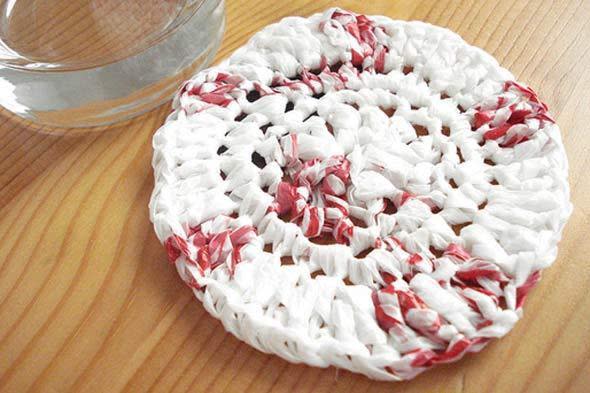VIDEO: Random Recast: New Uses for Grocery Bags Round-Up
In Random Recast, we find new uses for ordinary things. This week: Grocery bags.

Photo by: PrettyDaisies, Flickr
If I hadn't been searching for alternate uses forgrocery bags, I wouldn't have readily realized that this coaster was made from plastic sacks. To achieve this raffia-like texture, grocery bags are cut into strips and knotted together to create a type of yarn. (And there's even a special name for the stuff: Plarn.)
Crafters who work with plarn say that the thinner the bag, the better your results. Also, cut off the "tails" of the knots between strips, which will let you crochet smoothly. Once you've made the plarn, crochet a granny square to create coasters that are completely a-okay to leave outdoors all season.
Missed the other Random Recast posts? Check out...
Day #4: Outdoor Pillow Stuffing

Photo by: PlayfulLibrarian, Flickr
It's such a small complaint, but I really hate having to pay for a separate pillow insert when I buy pillow covers. And outdoor pillow inserts tend to be pricier than the standard size. Instead, stuff the new covers with plastic grocery bags.
Instead of stuffing your accumulatedgrocery bagsinto yet another bag, awaiting an occasion where you'll need to suddenly employ dozens of plastic sacks at once, use them to fill an outdoor pillow cover. Here's my rationale: Right now there are so many cute outdoor pillow covers on the market, which only fit the specialty-sized inserts sold separately (of course).
Plus, traditional inserts are made out of (and stuffed with) cotton, which can attract all sorts of bugs if there's a hole in the cover. So by stuffing the cover with grocery bags, you'll save at least $20 per pillow and keep your lounging spot bug-free. It's a win-win.
Day #3: Bowls, Cups and Planters

Photo by: supercyclers
To create watertight (and pretty indestructible) bowls, cups and planters, mold layers of plastic grocery bags around the object, then blast with a heat gun. Not as scary as it sounds, we promise.
Grocery bagscan be sewn into bags and folded into flowers, but did you ever think you could make a bowl out of the plastic sacks? Sarah and Liane ofSupercyclersdiscovered that it's possible to create water-tight bowls, cups and planters by gently heating grocery bags over objects. To do so, you'll need a heat gun, which is pretty easy to find at your local hardware store.
The ladies just have a word of caution before you get started: "There is a degree of plastic bag fumage, the worst lowest possible grade on the petrochemical chain, but you should never see actual smoke as you work. Wear a good quality respiratory face mask at all times and even [safety] glasses."
Gloves are also recommended, as you'll be able to really mold the grocery bags around the bowl or cup without worry. For complete instructions, visit theSupercyclers blog.
Day #2: Faux Flowers

Photo by: Elizabeth Abemathy
Whether you use a folding method or simply cut petals out of the bags, the resulting ethereal blooms are sure to please. We love them as gift toppers.
Faux flowers get a bad rap, but I think the key to using them in your home is to choose styles that are inspired by blooms rather than literal interpretations. These light-as-air poppies made from plasticgrocery bagsdefinitely fits the bill. Made by bloggerElizabeth Abernathy, the plastic flowers start with fused grocery bag "fabric." (We covered how to make the durable material in yesterday'sRandom Recast project.)
After fusing the grocery bags, Elizabeth cut out abstract petal shapes from the material. Then, she stacked the petals and secured the layers in the center with a pretty pin.
Though this method is very easy, there's another way to create ethereal flowers from plastic grocery bags. Simply cut the bag into rectangles of equal sizes, layer one on top of another then accordion-fold the stack together. Cinch the stack in the center with a twist-tie, then shape the ends into petal shapes with scissors. Unfold each petal to create a full peony-like flower. For more detailed instructions, check outNuno Magazine's tutorial. (Psst, the mag was created by Elizabeth!)
Day #1: Messenger Bag

Photo by: Will Taylor, ReadyMade
Layers of grocery bags sewn together create this utilitarian-chic messenger tote. For a less quilted look, you can also bond the bags together with an iron to create a thin "fabric" that will resist tearing and staining.
When is a plasticgrocery bagnot a plastic grocery bag? When it's used to create a useful (and incredibly sturdy) messenger bag. It's made by quilting together a bunch of plastic grocery bags together. Because you'll need about 17 plastic bags, this is a great time to clear that stash you've hoarded for future use. To get the full instructions, check outReadyMade's tutorial.
Another way to repurpose plastic grocery bags for sewing is to fuse them together to create a durable fabric. Just sandwich 4 grocery bags between parchment paper, then smooth with an iron to bond them. (This works best if you trim away the grocery bag handles.) For a full tutorial, visit ModCloth'spost on bonding grocery bags.
Stay tuned for next week's Random Recast. What will it be? You'll have to stay tuned...

This article originally appeared on HuffPost.

